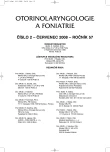Differential Diagnostics of Expansive Processes at the Child Age in ORL Area
Authors:
D. Janeček; K. Bartoňková; E. Vogazianos; I. Šlapák
Authors‘ workplace:
Klinika dětské otorinolaryngologie LF MUa FN, Brno
přednosta prof. MUDr. I. Šlapák, CSc.
Published in:
Otorinolaryngol Foniatr, 57, 2008, No. 2, pp. 59-64.
Category:
Original Article
Overview
From the differential diagnosis point of view, in addition to malignant and benign tumors at the child age, we have to consider also the occurrence of inborn malformations, paraneoplastic processes and vascular anomalies of head and neck. Most formations are of benign character. Malignant tumors include especially sarcomas, less often carcinomas. Most frequent malignity of head and neck in children is RMS and lymphomas. A high volume, tissue infiltration and painless palpation suggest malignity, whereas fluctuation, reddening and palpation sensitivity indicates inflammatory swelling. The affection of ear and temporal bone forms a very low percentage of children head and neck tumors (1.5% of primary tumors). Tumors at the middle floor and rhinobasis include especially parameningeal rhabdomyosarcoma, angiofibroma and rarely carcinoma. Tumors of oral cavity and pharynx are rare in children, and benign ones form 90% of them. Vascular tumors occur only below 6 years of age, odontogenic tumors are present in older children.
At the Clinic of Children Otorhinolaryngology, Teaching Hospital, Brno, 143 patients have been operated on in the years 2002-2006. In these patients, diagnoses and results of histological examination have been related to individual anatomical regions. Occasional re-operations are not included. Malignant head and neck tumors have been very rare and their symptoms were often not characteristic. Most of these tumors were of mesenchymal origin with a fast and destructive growth. In comparison with the statistics of adult patients, the incidence of children tumors in the head and neck region are significantly lower. There is also a principal difference in histology. Whereas in the adult patients epithelial tumors (carcinomas) prevail, these are in children and mostly benign cystic formations and vascular anomalies occur. Among malignant tumors most frequent are mesenchymal ones – lymphomas and sarcomas (rhabdomyosarcoma). Although children suffer more often from non-Hodgkin lymphomas, they encounter more frequently Hodgkin lymphoma in the head and neck region. In the therapy of malignant tumors at the child age, interdisciplinary cooperation and individual approach proved to be very important.
Key words:
tumors of older children, malignant tumor sof of head and neck, differential diagnosis.
Sources
1. Albright, J. T., Topham, A. K., Reilly, J. S.: Pediatric head and neck malignancies: US incidence and trends over 2 decades. Arch. Otolaryngol. Head Neck Surg., 128, 2002, 6, s. 655-659.
2. Bogomil‘skii, M. R., Iablonskii, S. V.: Benign tumors of the nasal cavity, paranasal sinuses and nasopharynx in childhood. Vestn. Otorinolaringol., 1999; 1, s. 58-62.
3. Castillo, B. V. Jr, Kaufman, L.: Pediatric tumors of the eye and orbit. Pediatr. Clin. North. Am., 50, 2003, 1, s. 149-172.
4. Gutjahr, P., Jung, H.: Contribution to the diagnosis, therapy and prognosis of head and neck tumors in childhood and adolescence: experience with 94 own case. Laryngál. Rhinol. Otol., 54, 1975, 7, s. :591-597.
5. Imhof, H., Czerny, C. Hormann, M., Krestan, C.: Tumors and tumor-like lesions of the neck: from childhood to adult. Eur Radiol., 2004, 14, Suppl. 4, s. 155-165.
6. Kazanowska, B., Reich, A., Reich, M., Balcerska, A., Balwierz, W., Bodalski, J., Dluzniewska, A., Drozynska, E., Katski, K., Kijowski, J., Kowalczyk, J., Kudypak, A., Matysiak, M., Mikolajewska, A., Peregut-Pogorzelski, J., Sopylo, B., Stencel, D., Szewczyk, B., Wachowiak, J., Wieczorek, M., Wysocki, M., Chybicka, A.: Remaining problems and controversies in the management of childhood head and neck soft tissue sarcomas: Retrospective (national) Multicenter Study of the Polish Pediatric Solid Tumors Group. Pediatr. Hematom. Oncol., 21, 2004, 4, s. 349-362.
7. Maier, W., Laubert, A.: Malignant head-neck tumors in childhood-an interdisciplinary challenge from the viewpoint of the ENT physician. Laryngorhinootologie, 75, 1996, 7, s. 415-418.
8. Muller, H., Winkler, U.: Differential diagnostic considerations in tumors in childhood in the ear-nose-throat speciality Pediatr. Grenzgeb., 28, 1989, 3, s. 175-180.
9. Munoz Borge, F., Gonzalez Alonso, J., Galera Ruiz, H., Delgado Moreno, F., Galera Davidson, H.: Advances in the diagnosis of ENT tumors in childhood. An Pediatr., 58, 2003, 5, s. 456-463.
10. Premachandra, D. J., Milton, C. M.: Differential diagnostic considerations in tumors in childhood in the ear-nose-throat speciality. Pediatr. Grenzgeb., 28, 1989, 3, s. 175-180.
11. Robertson, R. L., Robson, C. D., Barnes, P. D., Burrows, P. E.: Head and neck vascular anomalies of childhood. .Neuroimaging. Clin. N Am., 9, 1999, 1, s. 115-132.
Labels
Audiology Paediatric ENT ENT (Otorhinolaryngology)Article was published in
Otorhinolaryngology and Phoniatrics

2008 Issue 2
Most read in this issue
- Surgical Treatment of Parotid Gland at the Cliníc of ORL and Neck Surgery, Central Military Hospitál at Ružomberok in the Years 1995 - 2006
- Fibrous Dysplasia and Cholesteatoma
- Hirudotherapy in Reconstruction Surgery of Head and Neck – Our First Experience
- Differential Diagnostics of Expansive Processes at the Child Age in ORL Area
